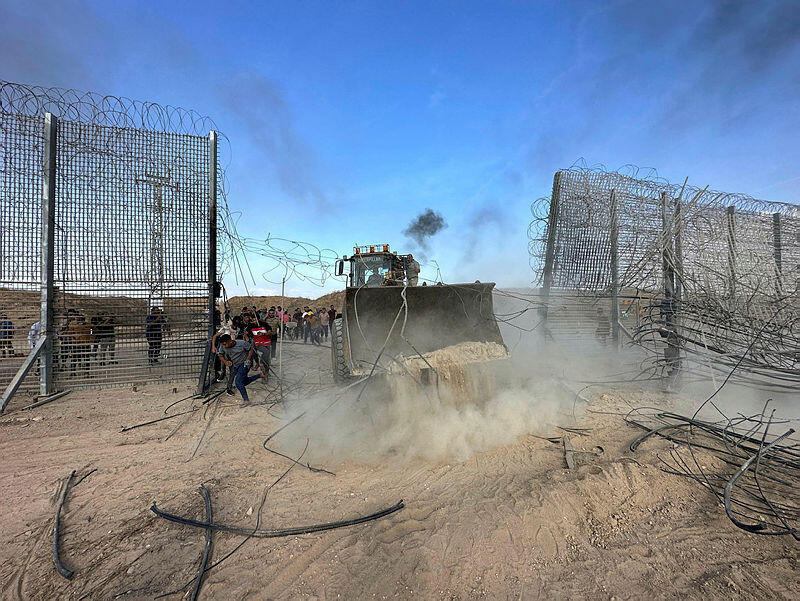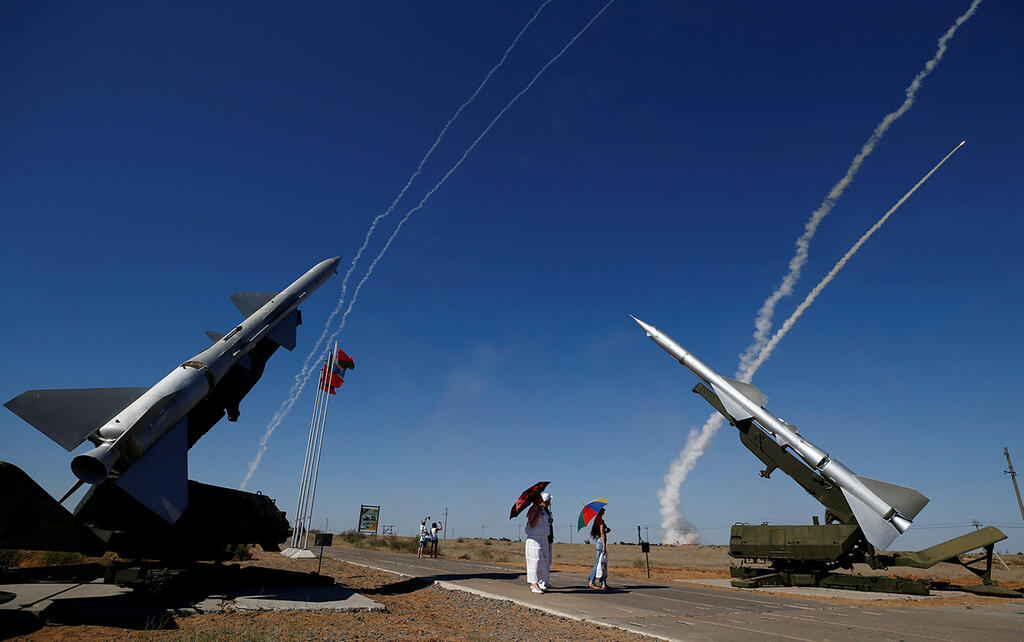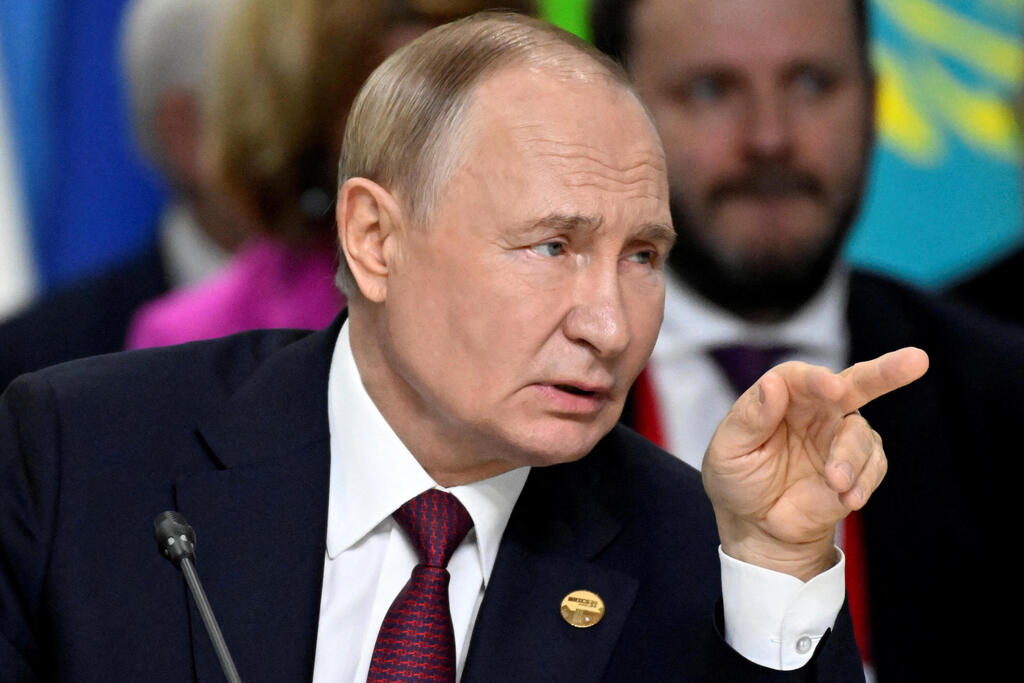Getting your Trinity Audio player ready...
Israel today is on the cusp of a major boost in its regional geopolitical position and a redressing single handily of the global balance of powers in the West’s favor. In large measure, the stunting turnaround is the result of fallacious decisions made by three main figures—Yahya Sinwar, the leader of the Hamas terrorist army in Gaza, Hassan Nasrallah, the leader of the Lebanese terrorist army Hezbollah and Ayatollah Ali Khamenei, the supreme leader of the Islamic Republic of Iran.
The fatefully wrong choices made by the three were undoubtedly the result of their fanatic religious perspectives. The first two were also convinced they were experts on anything Israel.
Sinwar
Sinwar underestimated Israel. Accustomed to years of “containment” on the part of the IDF, and “bribes” aimed to buy his inaction, he increasingly believed Israel was weak and unwilling to go to war. On top of it, he was clearly encouraged by the divisions in Israeli society, especially the open accounts of IDF’s reservists’ unwillingness to serve if called up. He likely concluded that his October 7 attack would result in another “round” of inconclusive fighting, dubbed by the IDF as “mowing the lawn,” and Israel’s yearning for a cease-fire even on his terms.
At the minimum Sinwar expected that the offensive would yield major political payoffs for Hamas and a dramatic elevation of his personal stature among Palestinians, Middle Easterners and world powers.
But Sinwar also overestimated the willingness of his terrorist allies to come to his aid and the power of the “ring of fire.” In so doing he evidently became a victim of both his own propaganda and his terrorist allies’ incessant glorifying of their military capabilities aimed to intimidate the “Zionist enemy.” Thus it apparently never crossed his mind that even if his partners in crime did come to his aid, they would all be beaten badly.
Besides, Sinwar was sure that by taking hostages he would force Israel to accept his cease-fire terms irrespective of how successful the Hamas attack actually was. After all, bargaining over the release of hostages always made Israel cave in.
However, precisely due to the miserable history of past hostage release bargains, the tactic backfired. This time the consensus quickly emerged freedom for the hostages could only be achieved by intensifying the IDF’s military pressure on Hamas.
Finally, information retrieved from Hamas hideouts in Gaza indicates that Sinwar also overestimated the ability of international opinion to stop the IDF.
Of course, in reality, the barbarism of the Hamas attack jolted Israel into instantly abandoning all its pre-October 7 strategic misconceptions and, under the slogan of “Never Again,” reverting to its proven offensive doctrine which stresses preemption against emerging threats. Hamas’ invasion erased any cracks that potentially threatened the readiness of the IDF. Instead, the Israeli military transformed into a unified force almost overnight, one willing and capable of fighting on multiple fronts for a prolonged period.
Time and again the IDF was able to demonstrate its unequaled operational, intelligence and technological superiority over each and all of Israel’s enemies combined.
Nasrallah
Nasrallah, undoubtedly under the direction of Iran’s mullahs, was prevented from invading Israel in conjunction with the Hamas attack which would have significantly complicated the IDF’s mobilization and counterattack. From the get-go, Tehran assessed that the Hamas attack was sufficient to force Israel to seek a cease-fire. Such an accomplishment would decisively demonstrate Israel’s stunning defeat, preserve Hezbollah as a strategic deterrent and codify Iran’s and its “axis of resistance” ascent to regional hegemony.
5 View gallery


Palestinian front loader breaks through Gaza border fence on October 7, 2023
(Photo: REUTERS/Mohammed Fayq Abu Mostafa)
But Iran also wanted to exhibit support for its proxies and in turn to become an integral part of the victory over Israel. The solution was to have Hezbollah join the fight via relentless bombardment of northern Israel but avoid a ground operation even though evidence now shows the organization was fully prepared for one logistically.
Hezbollah’s attacks on northern Israel were also meant to unnerve Washington. So long as Nasrallah fired into Israel, the specter of an all-out regional war on the eve of the U.S. presidential elections was kept alive. Iran and Nasrallah expected Biden to act accordingly and force a cease-fire in Gaza which Nasrallah pledged would also lead to cessation of hostilities in the north. By intensifying the attacks, Hezbollah and Iran figured out they could even increase pressure on the American president to act.
However, while Nasrallah and the mullahs were correct in assessing Biden’s reaction to the incessant fire, they failed to anticipate Israel’s insistence on accomplishing the aims of the offensive in Gaza.
Unfortunately for Nasrallah, opting for the static harassment tactic also gave the IDF all the time it needed to regroup and reinforce the defenses of Israel’s northern border so as to make any Hezbollah subsequent ground offensive impractical.
The Israeli Air Force was now free to conduct devastating precision strikes against Hezbollah’s personnel, infrastructure and arms depots in preparation for an IDF’s ground maneuver into Lebanon.
Nasrallah stuck to his pressure strategy even though it failed to force Israel to seek a cease-fire and would cost him dearly. Instead of climbing down the tall tree he had scaled on October 8, 2023, he allowed the IDF to pursue its strategy of tackling each front sequentially by first stabilizing the Gaza theater and then on October 1, 2024, turning all its energies to dealing with Hezbollah.
Incredibly, Nasrallah did not abandon his secret lair in the Beirut Dahieh neighborhood in search of a new hideout, although the depth of Israel’s intelligence penetration of his organization was plain to see. In mid-September, thousands of Hezbollah terrorists were the subject of pinpoint attacks when their beepers or walkie-talkies blew up simultaneously.
Thousands of Hezbollah pagers exploded nearly simultaneously
Nasrallah’s blunders proved to be fatal for him personally and his army. They also turned upside down the entire defense doctrine of his masters in Tehran. The errors he committed were the result of overestimating his terrorist army’s capabilities and that of his sponsors in Tehran. At the same time, his downfall was also due to a fundamental underestimation of Israeli society in general and the IDF‘s combat power in particular.
Israel’s then-defense minister Yoav Gallant aptly summed up the strategic significance of Nasrallah’s blunders when he visited the IDF’s Northern Command on October 29, 2024:
“I estimate the residual capacity of [Hezbollah’s]…projectiles and rockets to be on the order of 20% and it is also not organized in the way it was organized, in a way that it could fire volleys or similar things… I see a deep connection between the operation we did in Iran [on October 26] and what is happening with Hezbollah…When we [counterattacked] in Iran…we took into account that Hezbollah does not have a real response capability and indeed…the means prepared in order to harm Israel at a time when it needs to deal with Iran, [these capabilities] are paralyzed and it naturally also creates options for us to continue."
Khamenei
Khamenei and his mullahs’ string of catastrophic decisions is easy to trace. First, as a result of this clique buying into its own propaganda about the power of the resistance, Iran’s first line of defense—i.e. Hezbollah’s “second strike force”—has been all but eliminated, putting its own security and possibly the future of the Islamic regime itself on the line.
However, the damage inflicted by this mindlessness extends beyond the de-facto destruction of Hezbollah and thus the obliteration of Iran’s entire proxy strategy.
Khamenei himself bears much of the responsibility for the fiasco. He saw the decision to attack Israel directly as the culmination of Iran’s scheme to destroy Israel and confirmation of its claim to regional preeminence. In the wake of Iran’s first (failed) attack on Israel launched on April 13, 2024, he declared: “Debates by the other party about how many missiles were fired, how many of them hit the target and how many didn’t, these are of secondary importance. The main issue is the emergence of the Iranian nation and Iranian military’s will in an important international arena. This is what matters.”
Iran's October 1 ballistic missile attack on Israel
After the second barrage that Iran fired at Israel on October 1, Khamenei made a point of showing up in person as leader at Friday prayers—first time in some five years and amid speculation of potential targeting of Iranian officials—where he called the missile strike a “shining” job by Iran’s armed forces. He boasted “What our armed forces did was the least they could do against Israel.”
However, once Israel launched its devastating counterattack on October 26, 2024, the ayatollah began to change his tune. While stating that “the way to provide security [for Iran] is by [military] power,” he went on to say that "Responsible officials must properly understand and determine the appropriate course of action [against Israel]."
Like Nasrallah, Khamenei cannot afford to climb down from the “tree” of confronting Israel and sue for peace because such a turnaround would not only risk his position among his followers. It would amount to a tacit recognition that the God of the Jews is more powerful than his Allah.
Khamenei thus solved his dilemma by relegating the authority for deciding Iran’s response to the country’s “responsible officials.” The designation was made even though he is above the Iranian constitution and is the commander-in-chief of the armed forces, who determines peace and war and the decision to carry out any military action.
In effect, Khamenei has thrown his military commanders under the bus. If another attack on Israel ends up costing Iran its oil industry and/or its nuclear facilities, especially given that the country’s air defenses have been essentially neutralized by the Israeli October 26, 2024, attack, it will be their fault, not his.
Luckily, his excellency cared to bestow some divine guidance to these “responsible officials.” According to IRNA, the state-run news agency, Khamenei said “exaggeration [of Israel's attack] is wrong, but downplaying what they did is wrong as well.”
Allah’s messenger on earth—the Ayatollah Khamenei—has been exposed as a two-bit politician after his own survival.
5 View gallery


Ali Khamenei
(Photo: Office of the Iranian Supreme Leader/WANA (West Asia News Agency)/Handout via REUTERS)
Yet even before Iran’s “responsible officials “ have decided how to respond to Israel’s aerial blitz, the effects of the dire choices the ayatollah and his cohorts have already taken are beginning to ripple through.
The momentous resolution to confront Israel directly can end up undermining Tehran’s fresh strategic links to Russia.
It can even shake the foundation of the radical entente— the grouping of Russia, Iran, North Korea and Syria which is working to support each other while pursuing the common goal of undermining Western, specifically the U.S., position in key world areas.
Iran’s ability to supply missiles to Russia has been hit by the Israeli attack on weapons manufacturing facilities across the Islamic Republic. Satellite images showed some sites hit by Israel housed planetary mixers which are used to make solid fuel for ballistic missiles.
The destruction of the mixers could impact the capacity of Iran to export solid-fueled short-range ballistic missiles, like the Fath-360, to Russia at least in the short run.
Suddenly Moscow has found out that what it thought was a reliable and steady source for boosting its firepower versus Ukraine is anything but.
The events in the war in Ukraine and the military escalation between Israel and Iran may also provide reasons for optimism for NATO leaders, who reportedly are examining the Ukrainian and Israeli successes against the Russians' advanced systems.
Russia could also suffer a financial hit after three of each much-vaunted S-300 air defense systems based in Iran were all destroyed in the Israeli attack. The damage to the reputation of Russia’s arms industry cannot be underestimated.
In turn, the Israeli strike demonstrated to the Iranians that Russia will not stand by them or defend them – not only because it doesn’t want to, but also because it cannot.
Unlike the U.S., which took concrete measures to defend Israel and deter Iran, Russia's military and strategic support for Iran has yet to materialize. But Russian President Vladimir Putin is unlikely to dispatch Russian soldiers to Iran now that he is immersed in the Ukraine war and importing North Korean soldiers to shore up his own military. He also knows full well that firing on Israeli planes raiding Iranian targets would expose his air and naval bases in Syria to the wrath of the Israeli Air Force.
The cracks in the Russo-Iranian alliance should not come as a surprise. For a fanatical Islamic regime like Iran to seek protection from an “infidel” like Putin was always a marriage of (in)convenience. After all, it was Putin who said “in 1993… I went to Israel as part of an official delegation. Mama gave me my baptismal crossing to get it blessed at the Lord’s Tomb. I did as she said and then put the cross around my neck. I have never taken it off since.”
So far the Russian contribution to Iran’s defenses was a warning to Israel not to consider attacking Iran’s nuclear facilities. A statement carried by the state news agency TASS quoted Deputy Foreign Minister Sergei Ryabkov as saying on October 17 “We have repeatedly warned and continue to warn, to caution [Israel] against even hypothetically considering the possibility of a strike on [Iranian] nuclear facilities and nuclear infrastructure.”
However, the warning did not threaten some kind of Russian punishment if Israel went ahead with striking Iran’s nuclear installations. Rather the reason for the admonition was that such an attack “would be a catastrophic development and a complete negation of all existing principles in the area of ensuring nuclear safety."
What is more, Ryabkov’s warning came days after it was made public that Israel assured U.S. President Joe Biden that Iran’s nuclear and oil facilities are off its target list.
Little wonder that Putin has offered Russia’s good services to mediate the Israeli-Iran conflict.
Some reports alleged that as a result of the Israeli offensive against the so-called “axis of resistance “ another leg of the radical entente—the one involving Iranian-Syrian relations—has come under strain.
For example, it was pointed out that Syria, unlike Iraq, has remained silent about the reported use of its airspace by the Israeli Air Force on its way to attack Iranian targets on October 26, 2024.
At the minimum, it has been argued, Hezbollah may now be forced to evacuate forces from Syria (those who did not already flee to Iraq or Iran, of course) due to the heavy blows it suffered in Lebanon at the hands of the IDF. As it is doubtful that Iran-backed Iraqi militias will be able to fill the resultant void, an opportunity has opened up for Syrian dictator Bashar al-Assad to loosen ties to Iran and try to return to the bosom of the Arab League. The latter opened its doors to him in May 2023 after a 12-year boycott.
Lastly and most importantly, the ayatollah’s decision to confront Israel directly has exposed the specious tenets of the Iranian defense doctrine. Opting to operate from the outset of a conflict at the top rung of the escalation ladder could be an effective strategy vis-a-vis a weak opponent that cannot respond in kind.
However, such an approach would prove downright suicidal against a formidable opponent like the IDF which can easily outmatch every escalatory step Iran may undertake. Moreover, the exercise of such a strategy makes any subsequent attempt to de-escalate a sure sign of retreat if not defeat.
 Dr. Avigdor Haselkorn
Dr. Avigdor HaselkornIran was correct the first time when it chose to hide behind a proxy strategy to pursue its malign regional designs.
Consequently, there are now unmistakable signs of Iranian anxiety and dread. While Iranian leaders and military commanders have repeatedly vowed to annihilate Israel and turn Tel Aviv into “dust,” Kamal Kharrazi, an adviser to Khamenei, told the Hezbollah-linked Al Mayadeen broadcaster on October 1, 2024, that the Islamic Republic may review its nuclear doctrine if Tehran is exposed to an “existential threat.” Talk about a change in tone!
Ironically, while numerous Iranian officials have pooh-poohed the impact of the Israeli aerial attack of October 26, 2024, as of little impact, the ayatollah himself is implying otherwise. In a video released to the Iranian media on November 2, 2024, he said “the Zionist regime or the United States of America will definitely receive a crushing response to what they are doing to Iran and the Iranian nation and to the resistance front.”
It appears Khamenei, despite being made aware of his country’s increasingly precarious position, is unwavering in his mad determination to prove the power of Islam by transforming Iran into a martyrdom-seeking nation.
The three stooges
War is perhaps the most fateful human activity. If left to terrorists who operate as though they possess military expertise, command real or modern armies and dare to confront head-on one of the world’s top military machines, the end would invariably be their doom. Indeed, this result would not vary even if they don black (or white) turbans. Thus, in the annals of warfare, the names Sinwar, Nasrallah and Khamenei should forever be known as the three stooges who helped Prime Minister Benjamin Netanyahu revolutionize Israel’s global geostrategic position.
- Dr. Avigdor Haselkorn is a strategic analyst. He has been published widely on national security issues.
Get the Ynetnews app on your smartphone:








